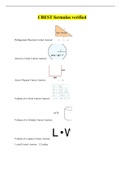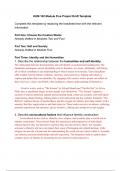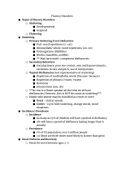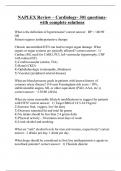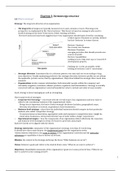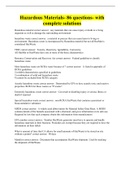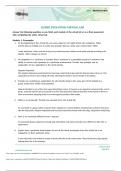SSEKWE
𝑼𝒏𝒍𝒐𝒄𝒌𝒊𝒏𝒈 𝑶′𝒍𝒆𝒗𝒆𝒍 𝑷𝒉𝒚𝒔𝒊𝒄𝒔
ROBERT
WAVES
A wave is a disturbance through a medium which transfers energy from one point to another
without causing any permanent displacement of medium itself.
Waves can be seen when;
▪ A stone is thrown into water.
▪ Oscillating a spring.
▪ A rope is fixed at one end and then jerked at another end.
CLASSIFICATION OF WAVES:
There are two classes of waves namely;
▪ Mechanical waves.
▪ Electromagnetic waves.
MECHANICAL WAVES:
These are waves that require a material medium to transfer energy from one point to another.
These waves are produced by vibrating bodies.
These waves can’t travel through a vacuum.
They normally have a low velocity.
Examples of mechanical waves include;
• Sound waves.
• Water waves.
• Waves in stretched strings.
ELECTROMAGNETIC WAVES:
These are waves that do not require a material medium to transfer energy from one point to
another.
They are produced by varying electric and magnetic fields.
They can travel through a vacuum.
All electromagnetic waves travel at a speed of light (𝟑 × 𝟏𝟎𝟖 𝒎𝒔−𝟏 )
Examples of electromagnetic waves include;
• Gamma rays
• X-rays
• Radio waves
• Infrared
• Visible light
• Ultra-violet light (UV), etc
𝑬𝒎𝒂𝒊𝒍: 𝒔𝒔𝒆𝒌𝒘𝒆𝒓𝒐𝒃𝒆𝒓𝒕@𝒈𝒎𝒂𝒊𝒍. 𝒄𝒐𝒎 𝑪𝒂𝒍𝒍: 𝟎𝟕𝟓𝟐𝟎𝟓𝟑𝟗𝟗𝟕 1
, SSEKWE
𝑼𝒏𝒍𝒐𝒄𝒌𝒊𝒏𝒈 𝑶′𝒍𝒆𝒗𝒆𝒍 𝑷𝒉𝒚𝒔𝒊𝒄𝒔
ROBERT
Differences between mechanical and electromagnetic waves.
Mechanical waves Electromagnetic waves
▪ They require a material medium for ▪ Don’t require a material medium for
their transmission. their transmission.
▪ They can’t travel through a vacuum. ▪ They can travel through a vacuum.
▪ They are produced by vibrating bodies ▪ They are produced by varying electric
and magnetic fields.
▪ They are slower. ▪ They are faster since they travel at a
speed of light.
REPRESENTATION OF A WAVE:
Waves are normally represented in form of oscillations or cycles.
Definition:
An oscillation is a complete to and fro movement of a wave.
𝑾𝒂𝒗𝒆𝒍𝒆𝒏𝒈𝒕𝒉, 𝝀
𝑫𝒊𝒔𝒑𝒍𝒂𝒄𝒆𝒎𝒆𝒏𝒕
𝑪𝒓𝒆𝒔𝒕 𝑹𝒆𝒔𝒕 𝒑𝒐𝒔𝒊𝒕𝒊𝒐𝒏
𝒂
𝑫𝒊𝒔𝒕𝒂𝒏𝒄𝒆/𝒕𝒊𝒎𝒆
𝒂
𝑷𝒆𝒓𝒊𝒐𝒅, 𝑻 𝑻𝒓𝒐𝒖𝒈𝒉
Rest position:
This is the undisturbed position of a wave.
Amplitude, a:
This is the maximum displacement of a wave particle from the rest position.
Crest:
This is the maximum displacement of a wave above the rest position.
Trough:
This is the maximum displacement of a wave below the rest position.
Wavelength, 𝝀:
This is the distance between two successive crests or troughs of a wave.
OR
This is distance covered in one complete oscillation/cycle.
Wavelength is measured in metres.
𝑬𝒎𝒂𝒊𝒍: 𝒔𝒔𝒆𝒌𝒘𝒆𝒓𝒐𝒃𝒆𝒓𝒕@𝒈𝒎𝒂𝒊𝒍. 𝒄𝒐𝒎 𝑪𝒂𝒍𝒍: 𝟎𝟕𝟓𝟐𝟎𝟓𝟑𝟗𝟗𝟕 2
, SSEKWE
𝑼𝒏𝒍𝒐𝒄𝒌𝒊𝒏𝒈 𝑶′𝒍𝒆𝒗𝒆𝒍 𝑷𝒉𝒚𝒔𝒊𝒄𝒔
ROBERT
Period, T:
This the time taken to complete one oscillation.
𝟏
𝑻=
𝒇
It is measure in seconds.
Frequency, f:
This is the number of oscillations per second.
𝟏
𝒇=
𝑻
It is measured in Hertz (Hz)
Wave form:
This is the shape of the wave.
Wave phase:
This is the timing of one oscillation of a wave in comparison with another oscillation of another
wave.
Wave particles are in phase if they are exactly at the same point at the same time at same
distance from rest position and are moving in the same direction.
B G
C H
D I
A F K
E J
Particles A and F and K are in phase.
Particles B and G are in phase.
Particles C and F are not in phase.
Particles A and D are not in phase.
VELOCITY OF A WAVE
This is the distance travelled by a wave per unit time.
𝒅𝒊𝒔𝒕𝒂𝒏𝒄𝒆
𝒗𝒆𝒍𝒐𝒄𝒊𝒕𝒚 =
𝒕𝒊𝒎𝒆
Since in one complete cycle/oscillation, a wave travels a distance equal to wavelength, 𝝀 in time
equal to period, T.
𝑤𝑎𝑣𝑒𝑙𝑒𝑛𝑔𝑡ℎ
𝑣𝑒𝑙𝑜𝑐𝑖𝑡𝑦 =
𝑝𝑒𝑟𝑖𝑜𝑑
𝜆 1
𝑉= 𝐵𝑢𝑡 𝑇 =
𝑇 𝑓
𝑇ℎ𝑒𝑟𝑒𝑓𝑜𝑟𝑒 , 𝑽 = 𝝀𝒇
𝑬𝒎𝒂𝒊𝒍: 𝒔𝒔𝒆𝒌𝒘𝒆𝒓𝒐𝒃𝒆𝒓𝒕@𝒈𝒎𝒂𝒊𝒍. 𝒄𝒐𝒎 𝑪𝒂𝒍𝒍: 𝟎𝟕𝟓𝟐𝟎𝟓𝟑𝟗𝟗𝟕 3
, SSEKWE
𝑼𝒏𝒍𝒐𝒄𝒌𝒊𝒏𝒈 𝑶′𝒍𝒆𝒗𝒆𝒍 𝑷𝒉𝒚𝒔𝒊𝒄𝒔
ROBERT
NOTE:
If the number of oscillations is not known then,
𝒕
𝑃𝑒𝑟𝑖𝑜𝑑, 𝑻 =
𝒏
Where t – time taken for 𝒏 oscillations.
Examples:
1. Calculate the frequency of the wave if its velocity and wave are 5ms-1 and 0.5m respectively.
𝑽 = 𝒇𝝀
𝟓 = 𝒇 × 𝟎. 𝟓
𝟓
𝒇=
𝟎. 𝟓
𝒇 = 𝟏𝟎𝒎
2. A vibrator of frequency 50Hz produces circular waves. If the distance between the two
successive crests is 5cm. find the speed of the waves.
𝟓
𝝀= = 𝟎. 𝟎𝟓𝒎
𝟏𝟎𝟎
𝑽 = 𝒇𝝀
𝑽 = 𝟓𝟎 × 𝟎. 𝟎𝟓
𝑽 = 𝟐. 𝟓𝒎𝒔−𝟏
3. A vibrator with a frequency of 20Hz vibrates for a distance of 25cm in 5 seconds. Find
(i) The speed of the wave produced
(ii) Wave length of the wave produced
(i) (ii)
𝟐𝟓 𝑽 = 𝒇𝝀
𝒅= = 𝟎. 𝟐𝟓𝒎, 𝒕 = 𝟓𝒔
𝟏𝟎𝟎 𝟎. 𝟎𝟓 = 𝟐𝟎𝝀
𝒅 𝟎. 𝟎𝟓
𝑽= 𝝀=
𝒕 𝟐𝟎
𝟎. 𝟐𝟓 𝝀 = 𝟎. 𝟎𝟎𝟐𝟓𝒎
𝑽=
𝟓
𝑽 = 𝟎. 𝟎𝟓𝒎𝒔−𝟏
4. A vibrator produces waves which travel a distance of 35cm in 2 seconds. If the distance
between two successive crests is 5cm. find
(i) The velocity of the waves
(ii) The frequency of the waves
(i) (ii)
𝟑𝟓 𝟓
𝒅= = 𝟎. 𝟑𝟓𝒎 𝒕 = 𝟐𝒔 𝝀 = = 𝟎. 𝟎𝟓𝒎 𝑽 = 𝒇𝝀
𝟏𝟎𝟎 𝟏𝟎𝟎
𝒅 𝟎. 𝟏𝟕𝟓 = 𝒇 × 𝟎. 𝟎𝟓
𝑽= 𝟎. 𝟏𝟕𝟓
𝒕 𝒇=
𝟎. 𝟑𝟓 𝟎. 𝟎𝟓
𝑽= 𝒇 = 𝟑. 𝟓𝑯𝒛
𝟐
𝑽 = 𝟎. 𝟏𝟕𝟓𝒎𝒔−𝟏
𝑬𝒎𝒂𝒊𝒍: 𝒔𝒔𝒆𝒌𝒘𝒆𝒓𝒐𝒃𝒆𝒓𝒕@𝒈𝒎𝒂𝒊𝒍. 𝒄𝒐𝒎 𝑪𝒂𝒍𝒍: 𝟎𝟕𝟓𝟐𝟎𝟓𝟑𝟗𝟗𝟕 4
𝑼𝒏𝒍𝒐𝒄𝒌𝒊𝒏𝒈 𝑶′𝒍𝒆𝒗𝒆𝒍 𝑷𝒉𝒚𝒔𝒊𝒄𝒔
ROBERT
WAVES
A wave is a disturbance through a medium which transfers energy from one point to another
without causing any permanent displacement of medium itself.
Waves can be seen when;
▪ A stone is thrown into water.
▪ Oscillating a spring.
▪ A rope is fixed at one end and then jerked at another end.
CLASSIFICATION OF WAVES:
There are two classes of waves namely;
▪ Mechanical waves.
▪ Electromagnetic waves.
MECHANICAL WAVES:
These are waves that require a material medium to transfer energy from one point to another.
These waves are produced by vibrating bodies.
These waves can’t travel through a vacuum.
They normally have a low velocity.
Examples of mechanical waves include;
• Sound waves.
• Water waves.
• Waves in stretched strings.
ELECTROMAGNETIC WAVES:
These are waves that do not require a material medium to transfer energy from one point to
another.
They are produced by varying electric and magnetic fields.
They can travel through a vacuum.
All electromagnetic waves travel at a speed of light (𝟑 × 𝟏𝟎𝟖 𝒎𝒔−𝟏 )
Examples of electromagnetic waves include;
• Gamma rays
• X-rays
• Radio waves
• Infrared
• Visible light
• Ultra-violet light (UV), etc
𝑬𝒎𝒂𝒊𝒍: 𝒔𝒔𝒆𝒌𝒘𝒆𝒓𝒐𝒃𝒆𝒓𝒕@𝒈𝒎𝒂𝒊𝒍. 𝒄𝒐𝒎 𝑪𝒂𝒍𝒍: 𝟎𝟕𝟓𝟐𝟎𝟓𝟑𝟗𝟗𝟕 1
, SSEKWE
𝑼𝒏𝒍𝒐𝒄𝒌𝒊𝒏𝒈 𝑶′𝒍𝒆𝒗𝒆𝒍 𝑷𝒉𝒚𝒔𝒊𝒄𝒔
ROBERT
Differences between mechanical and electromagnetic waves.
Mechanical waves Electromagnetic waves
▪ They require a material medium for ▪ Don’t require a material medium for
their transmission. their transmission.
▪ They can’t travel through a vacuum. ▪ They can travel through a vacuum.
▪ They are produced by vibrating bodies ▪ They are produced by varying electric
and magnetic fields.
▪ They are slower. ▪ They are faster since they travel at a
speed of light.
REPRESENTATION OF A WAVE:
Waves are normally represented in form of oscillations or cycles.
Definition:
An oscillation is a complete to and fro movement of a wave.
𝑾𝒂𝒗𝒆𝒍𝒆𝒏𝒈𝒕𝒉, 𝝀
𝑫𝒊𝒔𝒑𝒍𝒂𝒄𝒆𝒎𝒆𝒏𝒕
𝑪𝒓𝒆𝒔𝒕 𝑹𝒆𝒔𝒕 𝒑𝒐𝒔𝒊𝒕𝒊𝒐𝒏
𝒂
𝑫𝒊𝒔𝒕𝒂𝒏𝒄𝒆/𝒕𝒊𝒎𝒆
𝒂
𝑷𝒆𝒓𝒊𝒐𝒅, 𝑻 𝑻𝒓𝒐𝒖𝒈𝒉
Rest position:
This is the undisturbed position of a wave.
Amplitude, a:
This is the maximum displacement of a wave particle from the rest position.
Crest:
This is the maximum displacement of a wave above the rest position.
Trough:
This is the maximum displacement of a wave below the rest position.
Wavelength, 𝝀:
This is the distance between two successive crests or troughs of a wave.
OR
This is distance covered in one complete oscillation/cycle.
Wavelength is measured in metres.
𝑬𝒎𝒂𝒊𝒍: 𝒔𝒔𝒆𝒌𝒘𝒆𝒓𝒐𝒃𝒆𝒓𝒕@𝒈𝒎𝒂𝒊𝒍. 𝒄𝒐𝒎 𝑪𝒂𝒍𝒍: 𝟎𝟕𝟓𝟐𝟎𝟓𝟑𝟗𝟗𝟕 2
, SSEKWE
𝑼𝒏𝒍𝒐𝒄𝒌𝒊𝒏𝒈 𝑶′𝒍𝒆𝒗𝒆𝒍 𝑷𝒉𝒚𝒔𝒊𝒄𝒔
ROBERT
Period, T:
This the time taken to complete one oscillation.
𝟏
𝑻=
𝒇
It is measure in seconds.
Frequency, f:
This is the number of oscillations per second.
𝟏
𝒇=
𝑻
It is measured in Hertz (Hz)
Wave form:
This is the shape of the wave.
Wave phase:
This is the timing of one oscillation of a wave in comparison with another oscillation of another
wave.
Wave particles are in phase if they are exactly at the same point at the same time at same
distance from rest position and are moving in the same direction.
B G
C H
D I
A F K
E J
Particles A and F and K are in phase.
Particles B and G are in phase.
Particles C and F are not in phase.
Particles A and D are not in phase.
VELOCITY OF A WAVE
This is the distance travelled by a wave per unit time.
𝒅𝒊𝒔𝒕𝒂𝒏𝒄𝒆
𝒗𝒆𝒍𝒐𝒄𝒊𝒕𝒚 =
𝒕𝒊𝒎𝒆
Since in one complete cycle/oscillation, a wave travels a distance equal to wavelength, 𝝀 in time
equal to period, T.
𝑤𝑎𝑣𝑒𝑙𝑒𝑛𝑔𝑡ℎ
𝑣𝑒𝑙𝑜𝑐𝑖𝑡𝑦 =
𝑝𝑒𝑟𝑖𝑜𝑑
𝜆 1
𝑉= 𝐵𝑢𝑡 𝑇 =
𝑇 𝑓
𝑇ℎ𝑒𝑟𝑒𝑓𝑜𝑟𝑒 , 𝑽 = 𝝀𝒇
𝑬𝒎𝒂𝒊𝒍: 𝒔𝒔𝒆𝒌𝒘𝒆𝒓𝒐𝒃𝒆𝒓𝒕@𝒈𝒎𝒂𝒊𝒍. 𝒄𝒐𝒎 𝑪𝒂𝒍𝒍: 𝟎𝟕𝟓𝟐𝟎𝟓𝟑𝟗𝟗𝟕 3
, SSEKWE
𝑼𝒏𝒍𝒐𝒄𝒌𝒊𝒏𝒈 𝑶′𝒍𝒆𝒗𝒆𝒍 𝑷𝒉𝒚𝒔𝒊𝒄𝒔
ROBERT
NOTE:
If the number of oscillations is not known then,
𝒕
𝑃𝑒𝑟𝑖𝑜𝑑, 𝑻 =
𝒏
Where t – time taken for 𝒏 oscillations.
Examples:
1. Calculate the frequency of the wave if its velocity and wave are 5ms-1 and 0.5m respectively.
𝑽 = 𝒇𝝀
𝟓 = 𝒇 × 𝟎. 𝟓
𝟓
𝒇=
𝟎. 𝟓
𝒇 = 𝟏𝟎𝒎
2. A vibrator of frequency 50Hz produces circular waves. If the distance between the two
successive crests is 5cm. find the speed of the waves.
𝟓
𝝀= = 𝟎. 𝟎𝟓𝒎
𝟏𝟎𝟎
𝑽 = 𝒇𝝀
𝑽 = 𝟓𝟎 × 𝟎. 𝟎𝟓
𝑽 = 𝟐. 𝟓𝒎𝒔−𝟏
3. A vibrator with a frequency of 20Hz vibrates for a distance of 25cm in 5 seconds. Find
(i) The speed of the wave produced
(ii) Wave length of the wave produced
(i) (ii)
𝟐𝟓 𝑽 = 𝒇𝝀
𝒅= = 𝟎. 𝟐𝟓𝒎, 𝒕 = 𝟓𝒔
𝟏𝟎𝟎 𝟎. 𝟎𝟓 = 𝟐𝟎𝝀
𝒅 𝟎. 𝟎𝟓
𝑽= 𝝀=
𝒕 𝟐𝟎
𝟎. 𝟐𝟓 𝝀 = 𝟎. 𝟎𝟎𝟐𝟓𝒎
𝑽=
𝟓
𝑽 = 𝟎. 𝟎𝟓𝒎𝒔−𝟏
4. A vibrator produces waves which travel a distance of 35cm in 2 seconds. If the distance
between two successive crests is 5cm. find
(i) The velocity of the waves
(ii) The frequency of the waves
(i) (ii)
𝟑𝟓 𝟓
𝒅= = 𝟎. 𝟑𝟓𝒎 𝒕 = 𝟐𝒔 𝝀 = = 𝟎. 𝟎𝟓𝒎 𝑽 = 𝒇𝝀
𝟏𝟎𝟎 𝟏𝟎𝟎
𝒅 𝟎. 𝟏𝟕𝟓 = 𝒇 × 𝟎. 𝟎𝟓
𝑽= 𝟎. 𝟏𝟕𝟓
𝒕 𝒇=
𝟎. 𝟑𝟓 𝟎. 𝟎𝟓
𝑽= 𝒇 = 𝟑. 𝟓𝑯𝒛
𝟐
𝑽 = 𝟎. 𝟏𝟕𝟓𝒎𝒔−𝟏
𝑬𝒎𝒂𝒊𝒍: 𝒔𝒔𝒆𝒌𝒘𝒆𝒓𝒐𝒃𝒆𝒓𝒕@𝒈𝒎𝒂𝒊𝒍. 𝒄𝒐𝒎 𝑪𝒂𝒍𝒍: 𝟎𝟕𝟓𝟐𝟎𝟓𝟑𝟗𝟗𝟕 4


